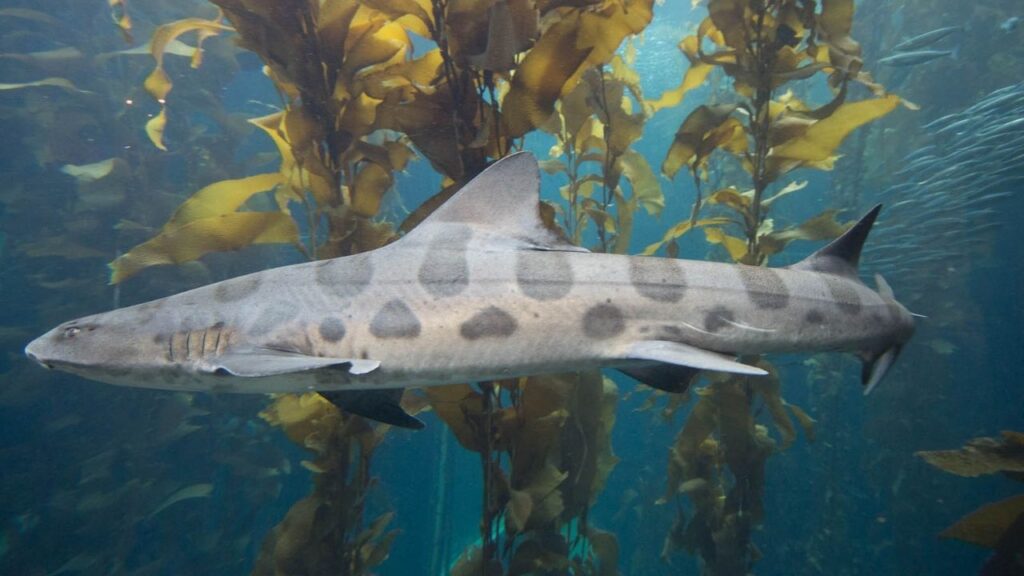Do Leopard Sharks Attack Humans? Leopard sharks are generally harmless to humans and rarely show aggressive behavior. Attacks are extremely rare, and these sharks are often considered safe for divers and swimmers.
Leopard sharks are mesmerizing creatures of the ocean, often seen gliding gracefully along coastal waters with their unique patterns and gentle nature.
For many beachgoers and marine life enthusiasts, the presence of these sharks sparks both fascination and curiosity. Do they pose any danger to humans? Are they aggressive, or do they prefer to mind their own business?
In this article, we’ll dive deep into understanding leopard sharks, their behavior, and why they’re considered one of the most harmless sharks in the ocean.
Contents
1. Introduction
Sharks often carry a reputation of danger and aggression, but this image isn’t entirely accurate, especially when it comes to leopard sharks.
Known for their beautifully spotted patterns and slim bodies, leopard sharks are common along the Pacific coast, particularly in California. [Do Leopard Sharks Attack Humans?]
These sharks, frequently encountered in shallow waters, often raise questions and concerns among swimmers, snorkelers, and divers. Could these sharks pose a danger to people? Or are they gentle giants of the coast?
2. What is a Leopard Shark?
Physical Description
Leopard sharks (Triakis semifasciata) belong to the houndshark family and are easily recognizable due to the distinct black or dark gray saddle-shaped spots along their backs and sides.
These spots give them their iconic “leopard” pattern, making them a standout among other shark species. [Do Leopard Sharks Attack Humans?]
They have a slender, elongated body with a flattened head and a mouth designed for suction rather than tearing.
Most leopard sharks grow to an average length of 3 to 4 feet, although they can reach up to 5 feet in some cases. Despite their size, they aren’t physically equipped to tackle large prey.
Habitat and Distribution
Native to the Pacific coast, leopard sharks are most commonly found from Oregon to the Gulf of California, with the highest population density occurring off the coast of California.
They prefer shallow coastal waters with sandy or muddy bottoms, often seen in bays, estuaries, and near kelp forests. [Do Leopard Sharks Attack Humans?]
These sharks are more likely to be found in warm waters during the summer months, when they come closer to shore to feed and breed.
Because of their habitat preference, they often come into close contact with beachgoers, raising questions about potential risks to swimmers.

3. Do Leopard Sharks Attack Humans?
Aggression Level
Leopard sharks are known for their non-aggressive behavior, and in most cases, they show little interest in humans.
Unlike some shark species that have a more aggressive nature, leopard sharks are typically calm and tend to avoid larger creatures, including humans.
Their mild temperament makes them highly popular for underwater observation and photography. [Do Leopard Sharks Attack Humans?]
Recorded Incidents
Instances of leopard sharks attacking humans are virtually non-existent. While many shark species have a history of unprovoked attacks, leopard sharks rarely, if ever, bite humans.
On the few recorded occasions where a bite has occurred, it was often a case of mistaken identity or due to the shark feeling threatened by the proximity of the swimmer.
Even in these cases, the injuries were minor, as the leopard shark’s bite force and tooth structure are not designed for attacking large animals.
Reasons for Low Aggression
Several factors contribute to the leopard shark’s low aggression level toward humans:
- Dietary Needs: Leopard sharks’ diet consists primarily of small, bottom-dwelling creatures like crabs, shrimp, and worms, which they crush with their specialized teeth. This feeding habit doesn’t lend itself to attacking larger animals.
- Physical Limitations: With small, blunt teeth designed for grinding rather than cutting, leopard sharks lack the physical attributes necessary for a dangerous attack on humans.
- Natural Temperament: These sharks exhibit a generally calm and non-territorial nature. They do not aggressively defend their space or view humans as threats, which further reduces the likelihood of an attack.
4. Why Leopard Sharks Are Considered Safe
Diet Preferences
Leopard sharks are bottom feeders, meaning they hunt and consume creatures that dwell near or on the seafloor. [Do Leopard Sharks Attack Humans?]
Their diet includes small fish, crabs, shrimp, and mollusks, which they locate using sensory organs on their snouts. The leopard shark’s diet keeps them in shallow waters but away from any typical human interaction zones.
Their natural prey is small, and their small mouth is suited for suction feeding rather than the classic “bite-and-attack” behavior associated with some other shark species.
Non-Territorial Nature
Leopard sharks do not have a territorial nature, which is often a driver of aggression in some animal species. [Do Leopard Sharks Attack Humans?]
Instead, leopard sharks are known for their social behavior, often found in groups, particularly during feeding or mating times.
This social structure allows them to coexist peacefully with other marine animals and minimizes any defensive or territorial behavior toward humans.
Behavior Around Divers and Swimmers
One of the reasons leopard sharks are favored among divers and snorkelers is their relaxed behavior around humans. [Do Leopard Sharks Attack Humans?]
They often continue about their activities, even if divers are nearby, and tend to swim away if they feel uneasy or threatened.
Their non-confrontational behavior makes them safe to observe up close, and many divers report that leopard sharks are some of the least skittish sharks they’ve encountered.
5. Safety Tips for Swimming Near Leopard Sharks
While leopard sharks are largely harmless, it’s important to exercise caution whenever encountering wild marine animals.
Here are some guidelines to ensure a safe experience for both you and the sharks:
Stay Calm and Respectful
Leopard sharks are peaceful creatures, and sudden movements or attempts to touch or chase them may cause stress.
Remaining calm and respectful of their space will not only protect you but also encourage positive shark-human interactions.
Avoid Feeding or Touching
Touching or feeding sharks, even if they seem harmless, can disrupt their natural behaviors. Feeding them can create an unnatural association with humans, potentially altering their behavior.
Observing from a respectful distance allows the shark to go about its business undisturbed. [Do Leopard Sharks Attack Humans?]
Best Practices for Marine Life Encounters
When encountering any marine animal, it’s best to maintain a safe distance, avoid any interaction that might alter its natural behavior, and avoid any sudden movements.
By following these guidelines, you’ll help preserve the natural environment and promote safe interactions between humans and marine life.
6. Final Verdict
Leopard sharks are some of the safest sharks you might encounter in the wild.
Their gentle demeanor, non-aggressive diet, and natural inclination to avoid larger creatures make them a joy to observe and photograph without worry.
Swimmers, divers, and beachgoers can rest assured that these sharks pose little to no risk. [Do Leopard Sharks Attack Humans?]
The presence of leopard sharks in coastal waters should be seen as an opportunity to appreciate marine biodiversity, as these sharks remind us of the ocean’s beauty and the need for respect and conservation of its inhabitants.
See Also: Do Bulls Attack Humans? Key Reasons!
7. FAQs
Are leopard sharks aggressive?
Leopard sharks are not aggressive and are generally considered safe for human interaction. [Do Leopard Sharks Attack Humans?]
Have there been any leopard shark attacks on humans?
There are very few, if any, documented cases of leopard sharks attacking humans. The rare instances of bites have been minor and accidental.
What should I do if I see a leopard shark while swimming?
If you see a leopard shark, stay calm, maintain a respectful distance, and avoid sudden movements. They are likely to swim away if they feel uncomfortable.
Can leopard sharks be kept in captivity?
Yes, leopard sharks can be kept in large aquariums where their needs are met. However, they require ample space, a carefully maintained habitat, and a diet similar to what they would find in the wild.
Are leopard sharks endangered?
Leopard sharks are not currently endangered, but their populations are protected in specific areas to prevent overfishing and ensure they thrive in their natural habitats.
8. Conclusion: Do Leopard Sharks Attack Humans?
In conclusion, leopard sharks are gentle creatures with little to no history of aggression toward humans. [Do Leopard Sharks Attack Humans?]
These beautiful sharks with their unique markings are a testament to the diversity of marine life and the wonder of our oceans.
Observing these sharks in their natural habitat can be a magical experience, but it’s essential to respect their space and avoid disrupting their environment.
By following safe and respectful practices, we can continue to coexist peacefully with leopard sharks, appreciating them without fear or harm.

Hello, I am Rosa Ellis, a mother of two and a wildlife blogger. I grew up in New York City, but I love exploring forests. I’ve traveled to places like Yellowstone National Park and the Amazon Rainforest to see animals up close. I know a lot about animal behavior and which animals can be dangerous to humans. Thanks for visiting my blog!

